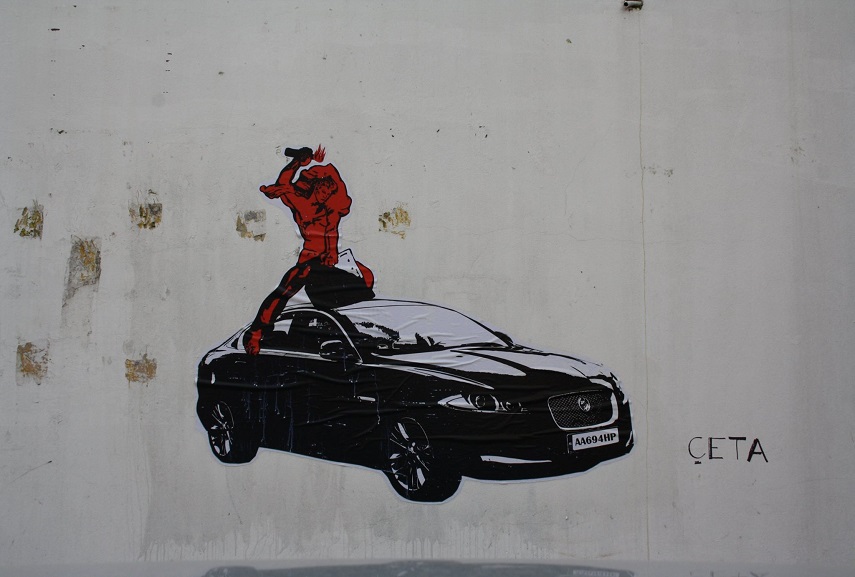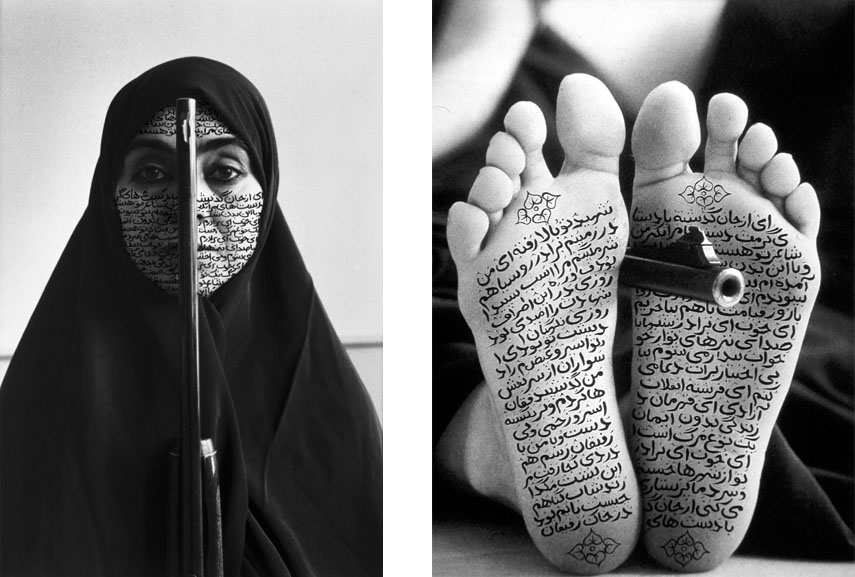Is Art an Effective Form of Social Commentary or Political Criticism?
What would be more than appropriate when examining art and politics than to outset with i of the Alain Badiou'south theses on gimmicky art: "It is better to do nothing than to contribute to the invention of formal ways of rendering visible that which Empire already recognizes equally existent."[1] In his brusque but powerful rendering of postulates of present-day arts in relation to modern structures of ordering, washed in xv theses, Badiou proposes an engaged explanation of art's purpose in relation to contemporaneity. The empire he mentions is not some politically established sovereign domain relative to ancient empires, although he starts his explanations by mentioning Roman Empire in detail, but a new system of structuring of reality founded on neoliberal, marketplace capitalism. What is rendered visible by this empire and what is best-selling should not business organization artists. Instead, politics of art should exist delivered through rendering visible what empire does not recognizes – the agential possibility of the then-chosen margins and their emancipation.
The of import role in any consideration of fine art and politics is their historical trajectory and connectedness through different epochs. Yet, information technology is also important to note the aesthetic potential of art, as the core of its political engagement. Aesthetics, or more than precisely "aesthetic regime" [ii], as theorized by Jacques Rancière, is distinguished from the so-chosen ethical and poetic regimes that previously defined fine art. Ethical government of images as explained by Plato relegates artworks to fickle, and untrue representations, while poetic regime makes representation of beauty and imitation as the artworks' main purposes. However, aesthetic regime equally proposed past Rancière breaks the barriers imposed by these two regimes between artistic practices and social and political spheres, and invests and engages arts with politics, society and idea.
Such approach to arts and aesthetics defines our present understating of politics and fine art. In what follows, a cursory historical overview of this relation will be followed past a look at some of the examples of contemporary art, including an overview of the contemporary urban scene.

Art and Politics from Modernity Onward
To discover relation between these two elements it is not necessary to look at specific period, fashion or creative move. Arts has ever been intertwined with politics, fifty-fifty when such slogans as fifty'art pour 50'art were professed. From mimetic to corrective tool, art served its given purpose and was influenced and shaped past different social weather and circumstances. Artistic production never solely replicated reality. Even during Realism it had its purpose of showing the brutality or dazzler of everyday life to viewers. In the Nazi and Soviet visual culture was heavily encumbered with additional meanings supportive of ideological stances. Some creatives succumbed to ideological brunt and created works that glorified political regimes, while in dissimilarity to such attitudes, alternative artistic practices developed, oftentimes confounded to groups with limited access to public domain. Historical avant-garde movements created an aesthetic insurrection in the commencement half of the 20th century, purposefully discarding non just the visual trends of the times, simply with them the social and moral mores too. Going against the dominant norms of time, avant-garde phenomenon opposed mainstream culture and traditional styles. From Futurism, Fauvism to Surrealism and Dadaism, avant-garde movements marked showtime of the 20th century and created some of the best-known works of art. Social movements were likewise followed by artistic expressions supportive of their ideas. Black Arts Motility was part of a broader social motility Black Ability, while Feminist art came as a logical outcome of the feminist movements of the 20th century.
Today, each artistic gesture is weighted confronting its emancipatory potential. Art has never been just a personal reflection of an creative person, unengaged from the world. It was always dialogical and confound within a web of contextual meanings. Marc James Léger argues that contemporary avant-garde exists as a counter-ability that "rejects the inevitability of capitalist integration." [3] His argument can be easily applied to present-twenty-four hour period artistic productions defined in more general terms as well. Although different issues and socially-engaged stances are addressed in artistic practices today, from environmental, racial, economic, and sexual, capitalist market system seem to swivel at the background of many of the nowadays-day problems, every bit explicated by Badiou and his 'empire' reference.
100 Meg Ceramic Husks for Social Change
Ai Weiwei'due south Sunflower Seeds
The work of Ai Weiwei titled Sunflower Seeds comprises of 100 one thousand thousand ceramic husks created to resemble in size, colour and shape their counterparts from the nature. The husks were produced for Weiwei by 1,600 artisans of whom many were unemployed at the time, in Jingdezhen, People's republic of china, a boondocks where purple porcelain was made for over a thousand years.[4] Upon completion, husks were transferred to a gallery space where visitors could walk on them. The work engages with stories from China'south past, only as well current global industrial product and systems of inequality this production perpetuates. Created by anonymous workers, Sunflower Seeds stands too for mass product of goods in Communist china, the vulnerability and fragility of worker's position, and problematic cultural and economic exchange present in the world today.
Exist sure to check out works by Ai Weiwei on our market!

Michael Heizer - Levitated Mass
Michael Heizer's Levitated Mass can be defined as a piece of Country Art or sculpture. It comprises of a massive 340-ton stone megalith that was transferred from a quarry and positioned on top of a trench made for this purpose, in the vicinity of the Museum of Contemporary Art in Los Angeles, and the La Brea Tar Pits, a resting place for prehistoric bones.[five] The piece of work's simplicity, similar to Sunflower Seeds, nonetheless creates a strong statement regarding the present status. Positioned between contemporary and ancient locations, and with the possibility given to people to walk or stand below the megalith, it signifies the burden of nowadays-24-hour interval relations between the past and the present, but also the crushing force of the nature, endangered by capitalist exploitation, which can easily destroy our frail existence.

Political and Cultural Aspects of Street Fine art
Perhaps the most powerful examples of political visual works tin can be establish on the streets of urban metropolises effectually the earth. Street visual civilisation emerged from the first elaborate graffiti made in the New York subways, to today's intricate murals that grade an indelible role of contemporary creative scene. Walls of public buildings seem to serve as a new stage for protesting political injustices, and economic, and sexual inequalities. Street creatives often deploy a much straightforward approach when it comes to sending a message when compared to other creative forms. Visual renderings of today's problems form the master topic of many street creatives, starting grade superstars such as Banksy. Fintan Magee's mural in Stavanger, Norway, reflects on the consequences of cut in oil prices on local economy and working class, while Pixel Pancho'southward graffiti in Florida, Confronting Monsanto, showcases two robots in the flower field, and hints at today's disconnectedness from, and corruption of nature past humans.

Çeta – Vojo Kushi is Still Alive
Recently, a group of immature creatives, students and activists from Albania created a commonage Çeta, with the aim to oppose hegemonic structures of capitalism in their country. They oppose political system in Republic of albania that exploits and marginalizes the poor, in the name of progress and European integration. The group and so far finished six projects that criticize outlawing of unlicensed nutrient sellers from rural regions, and gentrification of the Albanian capital Tirana. In Vojo Kushi is Still Alive the commonage references the famous Albanian-Yugoslav partisan guerrilla fighter who sacrificed his life during the 2nd Globe War. He famously mounted a fascist tank and threw a grenade into it, losing his life in the process. Here, Çeta cites the famous representation of the hero, only at present replacing tank with the Albanian Prime Minister's car. Every bit members of collective stated, like Vojo Kushi rose against fascism, they are now raising against neoliberalism, and corporatization of the state. [vi]

Politics of Arts Today
These graffiti show that visual works keep with their mission of political liberation. This liberation is constantly negotiated, and was present in different fourth dimension periods, historical circumstances, and visual forms. As seen from avant-gardes to feminist move, art in itself is a powerful political tool, and should aid in creation of new class of universality, distinct from the existing one. As Badiou contends:
"…without fine art, without creative creation, the triumph of the forced universality of coin and ability is a real possibility. And then the question of fine art today is a question of political emancipation, there is something political in art itself. There is not just a question of art's political orientation, like it was the case yesterday, today it is a question in itself." [vii]

Editors' Tip: Art and Politics At present
A highly illustrated, accessible guide to political art in the twenty-start century, including some of the most daring and aggressive artworks of recent times, this book past Anthony Downey in eleven thematic chapters addresses and contextualizes a range of topical subjects such as globalization, labor, technology, citizenship, state of war, activism, and information. The book highlights the radical changes in the approaches and techniques used by creatives to communicate their ideas, from the increment in collaborative, artist-led, and participatory projects to activism and intervention, documentary and archive work. Many high-profile creatives are featured, including Chantal Ackerman, Ai Weiwei, Francis Alys, Harun Farocki, Omer Fast, Subodh Gupta, Teresa Margolles, Walid Raad, Raqs Media Collective, Doris Salcedo, BrunoSerralongue, and Santiago Sierra.
References:
- Badiou A., (2004), Fifteen Theseses on Contemporary Art, Lacanian Ink, no. 23, pp.100-19.
- Rancière J., (2004), The Politics of Aesthetics, p.23.
- Léger M. J., (2012), Brave New Avant Garde: Essays on Contemporary Art and Politics, p.3.
- Bearding, Virtually Ai Weiwei's Sunflower Seeds, aiweiweiseeds.com [Oct 26, 2016]
- Knight C., (2012), Review: LACMA'south new hunk 'Levitated Mass' has some substance, articles.latimes.com [October 26, 2016]
- Isto R.E., (2016), The Politics of Street Fine art In Republic of albania: an Interview with Çeta, artmargins.com [October 26, 2016]
- Badiou A., Fifteen Theseses on Gimmicky Art, p. 100-19.
Featured images: JR - Face to Face Project, 2007. Prototype via robletat.wordpress.com; Jules de Balincourt - US_World_Studies III, 2005. Image via julesdebalincourt.com; Sophia Wallace - CLITERACY, 100 Natural Laws, 2012. Prototype via sophiawallace. All images used for illustrative purposes only.
Source: https://www.widewalls.ch/magazine/art-and-politics
0 Response to "Is Art an Effective Form of Social Commentary or Political Criticism?"
Post a Comment